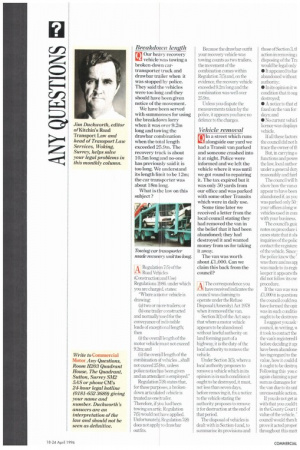Vehicle removal
Page 51

If you've noticed an error in this article please click here to report it so we can fix it.
In a street which runs alongside our yard we had a Transit van parked and someone crashed into it at night. Police were informed and we left the vehicle where it was until we got round to repairing it. The tax expired but it was only 50 yards from our office and was parked with some other Transits which were in daily use.
Some time later we received a letter from the local council stating they had removed the van in the belief that it had been abandoned; they had destroyed it and wanted money from us for taking it away.
The van was worth about £1,000. Can we claim this back from the council?
A The correspondence you
have received indicates the council was claiming to operate under the Refuse Disposal (Amenity) Act 1978 when it removed the van.
Section 3(1) of the Act says that where a motor vehicle appears to be abandoned without lawful authority on land forming part of a highway, it is the duty of the local authority to remove the vehicle.
Under Section 3(5), where a local authority proposes to remove a vehicle which in its opinion is in such condition it ought to be destroyed, it must, not less than seven days, before removing it, fix a notice to the vehicle stating the authority proposes to remove it for destruction at the end of that period.
The disposal of vehicles is dealt with in Section 4 and, to summarise its provisions and those of Section 3, t1 action in removing ; disposing of the Tra would be legal only • It appeared to hal abandoned without authority; • In its opinion it w. condition that it oug destroyed; • A notice to that ef fixed on the van for days; and • No current vehid licence was displayc vehicle.
If all these factors the council did not h trace the owner of tli But, in carrying o functions and powe the law, local author under a general dut3 reasonably and fairl The council will h show how the van a appear to have been abandoned if, as you was parked only 50: your offices along w vehicles used in coni with your business.
The council's guic notes on procedure cases state that it slit inquiries of the polic contact the registere of the vehicle. Since the police knew the'. was there and no apt was made to its regi: keeper it appears tht did not follow its ow procedure.
If the van was woi £1,000 it is question; the council could rea have formed the opit was in such conditio ought to be destroye I suggest you ask I council, in writing, IA it took to contact the the van's registered I before deciding it api have been abandone having regard to the value, how it could d it ought to be destro) Following this you c again claiming a par sum as damages for the van due to its unf unreasonable action.
If you do not get at with that you could t in the County Court I value of the vehicle. ' council would then h prove it acted proper throughout this matt




















































































































